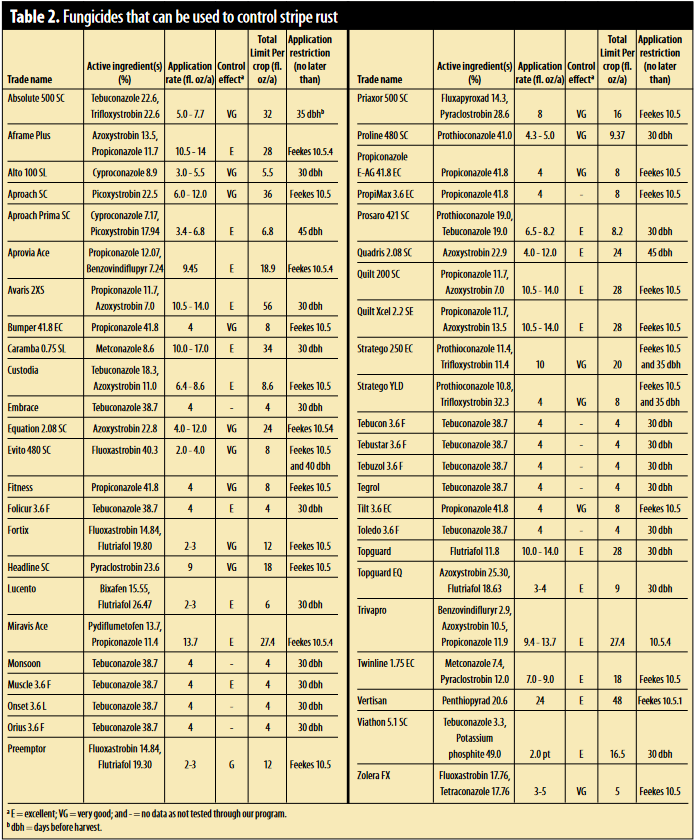Disease appears to be back for 2024 crop
By Xianming Chen
After the low levels of stripe rust in the past three years due to the long drought and hot conditions in 2021, cold winter for 2022 and 2023, plus the drought conditions for 2023, the disease appears to be back in the Pacific Northwest region for the 2024 wheat crop season.
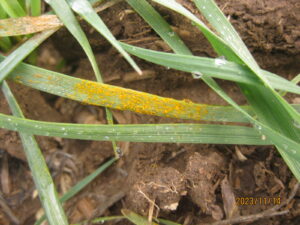
For 2024, stripe rust was forecast to be in the severe epidemic range based on the weather data from November and December 2023, with highly susceptible varieties to potentially have a yield loss of 43%. Based on the weather data of the entire winter from November 2023 to February 2024, we have predicted that stripe rust will likely cause 51% yield loss on highly susceptible varieties. Under such a level of epidemic, commercially grown varieties would suffer yield losses ranging from 0 to 33% depending upon varieties, or 8% on average, if not sprayed with fungicides.
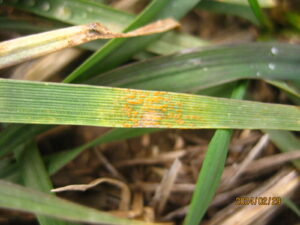
Our field surveys support the prediction. On Nov. 14, 2023, we found stripe rust in a commercial wheat field in Lincoln County (Figure 1). Although the incidence of stripe rust was below 0.1 percent, stripe rust was quite easy to find with two to four leaves infected in some spots. That was the first time since 2018 we’ve seen stripe rust infection in the fall. The fall infection of the stripe rust fungus shows the existence of the fungal pathogen in the field, but may not survive the winter, depending upon how cold the winter is and whether the field is covered with snow.
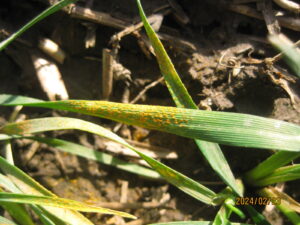
When we were checking this field on Feb. 29, 2024, we found stripe rust again, showing that the fungus has successfully overwintered and is ready to produce spores for infecting the wheat crops in the region and beyond (Figure 2). We also found stripe rust in another commercial wheat field further south in Adams County along Highway 21. When I stopped in our stripe rust monitoring nursery in Walla Walla on Feb. 23, I easily found several spots of stripe rust on the first or second leaves actively producing new spores and some spots had three to six sporulating leaves (Figure 3). Such early appearance of stripe rust in multiple locations in the State of Washington east of the Cascade Mountains was not seen from 2011 to 2023 and indicates a potentially severe epidemic of stripe rust in 2024 in the wheat growing areas of Washington and other areas in the eastern Pacific Northwest.
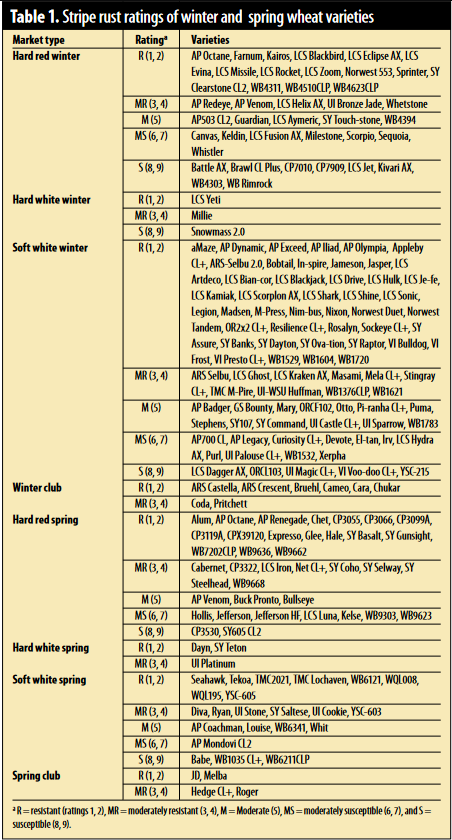 The early appearance of stripe rust and predicted potential severe epidemic make it necessary to spray a fungicide in fields planted with moderate (rating 5), moderately susceptible (ratings 6, 7), or susceptible (ratings 8, 9) varieties of winter wheat at the time of herbicide application and select resistant (ratings 1, 2) or moderately resistant (ratings 3, 4) spring wheat varieties to plant. It is best to avoid planting susceptible and moderately susceptible spring wheat varieties. Table 1 lists winter and spring wheat varieties in each of the categories of stripe rust ratings.
The early appearance of stripe rust and predicted potential severe epidemic make it necessary to spray a fungicide in fields planted with moderate (rating 5), moderately susceptible (ratings 6, 7), or susceptible (ratings 8, 9) varieties of winter wheat at the time of herbicide application and select resistant (ratings 1, 2) or moderately resistant (ratings 3, 4) spring wheat varieties to plant. It is best to avoid planting susceptible and moderately susceptible spring wheat varieties. Table 1 lists winter and spring wheat varieties in each of the categories of stripe rust ratings.
A large number of chemicals with different trade names are available for selecting to control stripe rust (Table 2). Most of the fungicides listed in the table have been tested through our programs during the past two decades. These chemicals can be classified based on their modes of actions or active ingredients. Relatively old fungicides, such as Tilt belonging to the triazole class and Headline in the strobilurin class, have only one active ingredient. Some recently developed fungicides, such as Absolute, Prosaro, and Quilt Xcel, have two active ingredients. The more recently developed fungicide Trivapro has three active ingredients. In general, fungicides with two or more active ingredients have better efficacies on control of stripe rust than the ones with only one active ingredient.
Although we have found mutants with some tolerance to propiconazole fungicides in the stripe rust pathogen population, the frequency of mutant isolates is still low, and use of this class of fungicides at the labeled rates still reduces stripe rust. However, it is recommended to rotate fungicides with different modes of action or use fungicides with combined modes of action to reduce the selection pressure for tolerance to a particular chemical like propiconazole. Every fungicide listed in Table 2 has a total limit quantity, and most of them cannot be used more than two times during a single crop season.
As stripe rust has started very early, two or more applications could be needed for fields grown with susceptible varieties depending upon the weather conditions in the late spring and early summer. Selecting fungicides with a longer protection period could reduce the number of applications. In general, fungicides marked with excellent (E) for control effect last longer than those marked with very good (VG), and those containing two or more active ingredients provide longer protection than those containing only one active ingredient (Table 2). In addition to the total limit quantity, every fungicide also has a restriction on use beyond a crop growth stage or number of days before harvest. Read the chemical labels for safe and effective use of fungicides in managing stripe rust in your fields.
In summary, please use stripe rust ratings in Table 1 or the SeedBuying Guide to select resistant spring wheat for planting and for the winter varieties planted in your fields to determine whether fungicide application is needed at the time of herbicide application and later in the crop season. Check fields for re-emergence of stripe rust to determine if a second application is needed. The information provided in Table 2 can be used to select fungicides. We will continue providing rust updates and related recommendations throughout the crop season.
If you have any questions for stripe rust management, please contact me through email at [email protected] or [email protected].
This article originally appeared in the April 2024 issue of Wheat Life Magazine.

Xianming Chen, Ph.D.
Xianming Chen is a research plant pathologist with the USDA-ARS and an adjunct professor at Washington State University. His research interests include foliar diseases of wheat and barley, especially rusts. He also works on epidemiology and control of rusts, including cultural, chemical, and disease resistance. His work contributes to the development of models for predicting rust epidemics. Read more about Dr. Chen.

